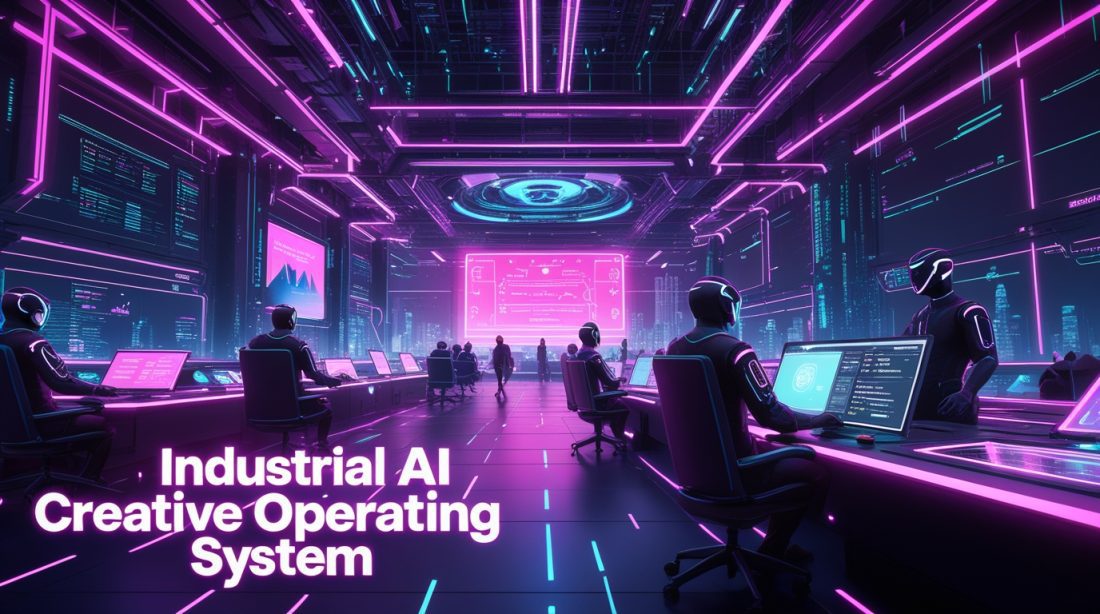The new industrial AI canvas
An industrial AI creative operating system is no longer a futuristic concept—it’s here, and Canva’s Creative OS is leading the charge. Imagine a marketing team at a mid-sized e-commerce company that once struggled to maintain brand consistency across 30 different product lines. Before Canva’s Creative OS, this meant constant manual reviews, fragmented workflows, and campaign delays that cost both time and revenue. Today, that same team launches coordinated, on-brand campaigns across multiple channels in hours, not weeks—all through a unified AI-powered platform that understands their brand identity as well as they do.
This isn’t a hypothetical scenario. It’s the reality that Canva’s Creative Operating System enables, representing what the company calls the dawn of the “Imagination Era“—a shift from information access to creative amplification. In an industrial AI context, this platform marks a significant evolution: Canva is transforming from a design tool into a comprehensive visual communication infrastructure that serves 95% of Fortune 500 companies.
With over 260 million monthly active users and $3.5 billion in annualized revenue, Canva has leveraged its massive design dataset to build what it claims is the “world’s first AI model trained to understand the complexity of design” . This specialized training approach represents an industrial AI strategy we’re seeing across sectors: vertical-specific models trained on domain-specific data that outperform general-purpose AI for specialized tasks.
Why industrial AI is revolutionizing creative work: The core architecture
The Canva Design Model difference
What sets Canva’s approach apart in the industrial AI landscape isn’t just another generative AI tool—it’s a system fundamentally engineered to understand design logic. While most AI models generate static images, the Canva Design Model comprehends design structure, layering, visual hierarchy, and branding principles to create fully editable content in seconds .
This technical differentiation matters for industrial applications because it reduces revision cycles and maintains brand integrity at scale. As Canva co-founder Cameron Adams explained to The Verge, the platform has “moved beyond just being an application layer, and it’s truly how you can run your entire creative process and workflows” .
AI where you actually work
The implementation philosophy behind Creative OS reflects what industrial AI practitioners call “embedded intelligence“—AI that functions within existing workflows rather than requiring separate interfaces. With AI-Powered Designs and AI-Powered Elements, users can generate complete, editable designs or individual components directly within the editor .
The Ask @Canva feature takes this further, functioning as what the platform describes as a “creative teammate” available through simple tagging in comments . This approach to human-AI collaboration represents the industrial AI principle that the most effective AI doesn’t replace workers but augments their capabilities in context.
Table: Canva Creative OS Core AI Capabilities
| AI Feature | Industrial Application | Workflow Impact |
|---|---|---|
| Canva Design Model | Brand-consistent design generation | Reduces design debt and revision cycles |
| AI-Powered Elements | Context-aware asset creation | Eliminates cross-tool workflow fragmentation |
| Ask @Canva | Collaborative design feedback | Accelerates iteration and approval processes |
| Style Match | Automated brand compliance | Ensures visual consistency across teams |
| Magic Background | Intelligent layout completion | Reduces manual design tasks |
Why marketing needs an AI operating system: The Canva Grow advantage

Closing the marketing loop
For industrial AI applications, the most significant metric is closed-loop performance—systems that not only execute tasks but learn from outcomes to improve over time. Canva Grow delivers this for marketers by bringing “creation, publishing, and performance together in one place” .
The platform allows marketing teams to design ads, publish directly to platforms like Meta, and track performance with AI-powered recommendations that inform future creative decisions . This data-driven creative cycle represents what industrial AI promises at its best: self-optimizing systems that become more effective with use.
The industrial logic of integrated workflows
From an industrial engineering perspective, workflow fragmentation represents one of the largest sources of efficiency loss in creative operations. Canva’s response in Creative OS is a suite of interconnected tools that eliminate context switching:
- Video 2.0 provides a reimagined editing environment with a simplified timeline and Magic Video capabilities that can transform raw clips into polished content
- Email Design enables creation and HTML export of branded campaigns without switching to dedicated email platforms
- Forms with automatic response collection in Canva Sheets creates seamless data-design workflows
As one industry analyst notes, “Canva has come a long way from being a web-based graphic design platform” —it’s now positioned as an integrated marketing engine that competes with specialized tools across the creative workflow spectrum.
Why brand consistency at scale is now an AI problem
The brand management challenge
For large organizations, brand consistency becomes exponentially more difficult with growth. Canva’s new Brand System addresses this through industrial AI principles: centralized governance with distributed execution. The system brings “brand guidelines and assets directly into the editor, so teams can access everything they need right where they create” .
The AI’s ability to “generate designs that reflect your colors, fonts, tone, and style automatically” means that every creation starts from a brand-compliant foundation. This application of constraint-based AI represents a sophisticated approach to a fundamental industrial challenge: how to maintain standards while enabling creativity.
The Affinity strategic play
In perhaps its most dramatic move, Canva has made the professional design suite Affinity free “for everyone, forever” . This decision makes sense within an industrial AI strategy: by removing cost barriers to professional-grade design tools, Canva expands its potential user base and training data collection.
The integration also creates a capability continuum—from professional designers using Affinity’s precision tools to marketing teams using Canva’s streamlined interfaces—all within the same ecosystem. As Lifehacker notes, this move clearly positions Canva “to eat Adobe’s lunch” by challenging the subscription model that has dominated creative software.
Why Canva’s Industrial AI Creative Operating System Is Reshaping the Future of Visual Communication
The platform consolidation play
Canva’s Creative OS represents a broader trend in industrial AI: platform consolidation. Rather than offering standalone AI tools, Canva has embedded AI throughout an integrated system that spans the entire creative workflow from ideation to performance analysis .
This approach mirrors what we’ve seen in other AI-driven sectors: vertical integration creates competitive advantages that specialized point solutions struggle to match. As Canva states, the result is “a faster, smarter, and more connected way to design, where human creativity leads and AI amplifies what’s possible” .
The data advantage
In industrial AI, domain-specific training data often proves more valuable than algorithmic innovations alone. Canva’s access to “over a decade of innovation” and the design behaviors of hundreds of millions of users provides a training dataset that would be virtually impossible for competitors to replicate.
This data advantage enables the Canva Design Model to understand “every aspect of design from structure and layering to hierarchy, branding, and visual logic” in ways that general-purpose models cannot.
How to approach adoption: Implementation insights
Starting with business needs
For organizations considering Creative OS, the most effective approach matches specific business capabilities to identified pain points:
- Marketing teams should focus on the end-to-end campaign management capabilities of Canva Grow
- Brand managers will find immediate value in the Brand System’s enforcement of visual identity
- Content creators can leverage Video 2.0 and AI content generation to accelerate production cycles
- Small businesses can access enterprise-grade capabilities through the new Canva Business plan at $20 per person monthly
The integration mindset
Canva’s Creative OS delivers maximum value when approached as a connected system rather than isolated tools. The platform’s ability to move data seamlessly from Forms to Sheets to visualizations creates compound efficiency gains that exceed the sum of individual feature improvements.
The bottom line: An industrial AI platform matures

Canva’s Creative Operating System represents a significant maturation of industrial AI applied to creative work. By moving beyond isolated AI features to a comprehensively reimagined workflow, Canva has created what might be described as an AI-native operating environment for visual communication.
The platform’s integration of design intelligence, brand management, and performance optimization within a unified environment offers a compelling vision for how industrial AI can transform creative work—not by replacing human creativity, but by amplifying it through constrained agency and intelligent assistance.
As Canva CEO Melanie Perkins notes, “As knowledge becomes more and more accessible, we believe we’re moving from the Information Era to the Imagination Era” . In this emerging era, competitive advantage won’t come from access to information alone, but from the ability to transform that information into compelling visual narratives at scale—exactly what Canva’s Creative OS is engineered to deliver.
Fast Facts
Canva’s Creative OS is an industrial AI creative operating system that combines a design-specific AI model, integrated marketing tools, and brand management systems to create an end-to-end environment for visual communication. It represents a shift from tool collection to connected creative workflow, serving 95% of Fortune 500 companies with a unified system for design, collaboration, and performance tracking.
FAQs
What is Canva’s Creative Operating System?
Canva’s Creative Operating System is a comprehensive AI-powered platform that brings together design creation, marketing execution, and performance analytics in a unified environment. It’s built on what Canva describes as the world’s first AI model specifically trained to understand design complexity.
How does Canva’s AI differ from other design AI?
Canva’s AI is specifically trained on design principles—understanding layout, hierarchy, branding, and visual logic—rather than just generating images. This allows it to create fully editable, brand-consistent designs rather than just static outputs.
What is Canva Grow?
Canva Grow is an end-to-end marketing platform within Creative OS that enables teams to create ads, publish to platforms like Meta, and track performance with AI-powered insights that help optimize future campaigns based on actual performance data.
Is Affinity really free now?
Yes, Canva has made the professional design suite Affinity “free for everyone, forever”. This includes tools for vector graphics, photo editing, and page layout that integrate with the broader Canva ecosystem.
How much does Canva Business cost?
Canva Business is priced at $20 per person per month with no seat minimum, positioning it between Canva Pro and Canva Enterprise while including advanced AI, analytics, and brand tools.
Stay Ahead in Industrial AI
Join our newsletter for monthly analysis of AI platform developments, implementation case studies, and industrial AI strategy insights. [Subscribe Now]
Further Reading
- Learn how Three Lives of a Robot explores the evolution of industrial AI agents across creative, operational, and strategic roles.
- Discover how AI Downtime Prediction is monetized through performance analytics—mirroring Canva Grow’s closed-loop creative cycle.
- See how White-Label AI Dashboards are transforming industrial platforms into customizable ecosystems, much like Canva’s Creative OS.
- Explore AI-Driven Tactical Communications for insights into embedded intelligence and workflow integration.
- Understand how AI Career Pathing reflects the human-AI collaboration model Canva promotes through Ask @Canva and embedded design intelligence.
